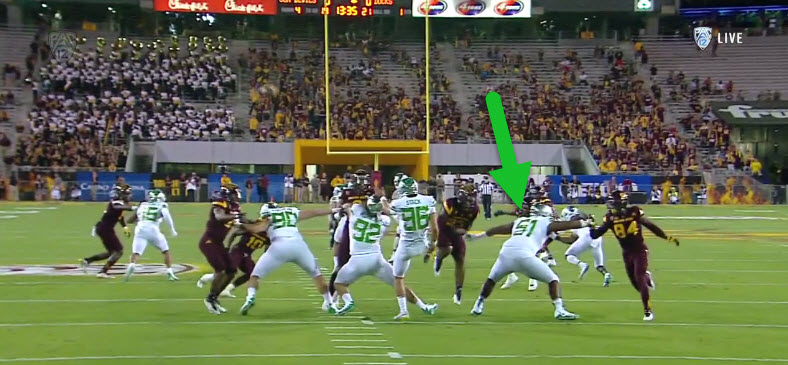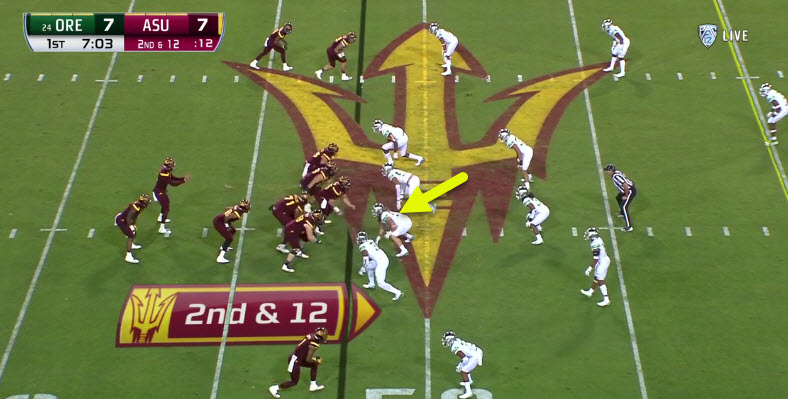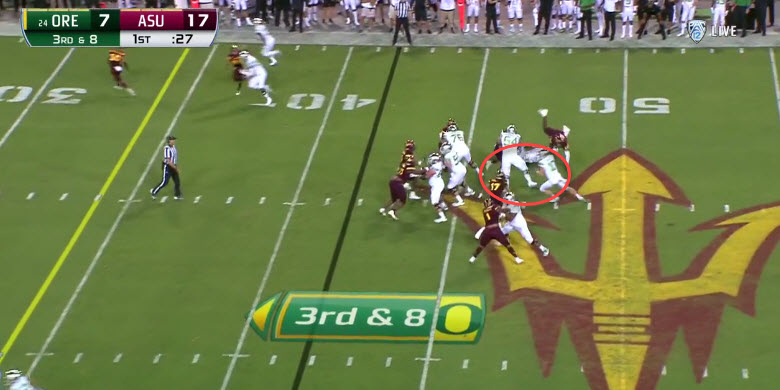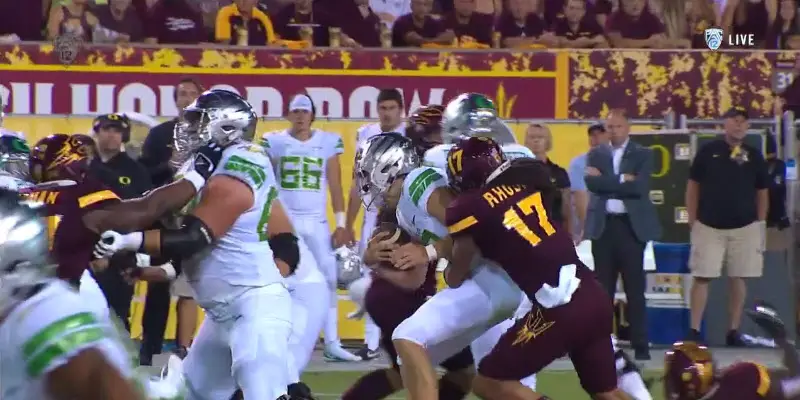Oregon’s three-game victory bubble burst in the desert last weekend as Arizona State kicked a field goal with 2:34 left to knock off the Ducks 37-35. After impressive success in non-conference play, the offense misfired from the start and breakdowns in all phases of the game showed that coach Willie Taggart and his staff have some serious coaching to do to get this team ready for the rest of the Pac-12 season, beginning Saturday in Eugene against a tough and dangerous Cal squad.
The Gulf Coast Offense, Taggart’s strong suit, sputtered from the very start. On the first play a wide receiver dropped a 45-yard, perfectly thrown pass from Justin Herbert. On the second, a lineman false started. On second-and-15, Royce Freeman was stuffed for a two-yard gain. On third down, Freeman had a screen pass with no one around except for the tackler the center should have blocked. On fourth down (after another false start), for the second straight game, the “shield” part of the punt protection allowed penetration and the punter had to shank the punt to keep it from getting blocked. Arizona State then started on Oregon’s 40-yard line and scored on an easy drive.
In the video above, Arizona State puts on a punt rush against Oregon’s shaky punt protection. The front seven should get their hands on the defenders and jam them hard enough to put them off balance, before releasing into coverage. The center should try to get a piece of anyone coming in his gap, which he doesn’t here. The right tackle allows his inside rusher a free release — he should hit him like the right end did to his inside rusher.

Not the best decision…
Even with four rushers coming in on three big blockers, if Gary Baker (No. 51 and green arrow above) has the proper split (foot to foot as the two blockers to his left are doing), he would block the most dangerous rusher, who is always the rusher closest to the punter. If he can’t get the outside rusher, that’s fine, the punter should still be able to get the ball away before the outside guy gets home.
The Ducks have now ensured that every team they play will come after their punts. The front players have to do a better job of holding up rushers before they release and the shield has to get tighter and more disciplined. This looked like high school punt protection.

Watch this player….
This play demonstrates the inconsistency of the pad level from Oregon’s defensive linemen. Henry Mondeaux (No. 92) and yellow arrow above is slow off the ball and stands up, rather than firing out low into the right guard who, with a clear pad level advantage, pancakes Mondeaux flat on his back.
It doesn’t help that the middle linebacker (#39) is lost and Jalen Jelks (#97) is being held by his blocker. As the above play demonstrates, poor pad level may account for ASU dominating the line of scrimmage to the tune of 187 yards rushing. Look for Cal to take advantage of this deficiency on Saturday.
As a positive aside, over the course of the game Jelks demonstrated consistently low pad level, which may account for his two sacks and five tackles for loss.
Henry Mondeaux (No. 92) demonstrates better, low pad level above. By doing so, he is able to nullify the charge of the offensive lineman and make the play, stuffing the ball carrier for a short gain. The middle linebacker, Kaulana Apelu (#39) is also able to avoid a blocker and help on the tackle. Because of his small size (5-11, 200), teams will continue to run at Apelu as he faces a physical mismatch with every interior blocker in the Pac-12 conference.

Not a surprise….
Above, the Ducks should have been better prepared to handle this blitz on a passing down early in the game. With two receivers stacked wide on each side of the formation, Herbert faced an all-out blitz from the Sun Devils, hardly a surprise given their long tradition of blitzing. There are two main problems here: the first is that the coaches did not call short, quick routes to combat the blitz, which would have allowed Herbert an opportunity to get off the pass before he was engulfed. In this situation, all four receivers are eight yards deep with their backs turned to Herbert as he is getting sacked.
The second problem is that the outside rusher on Oregon’s left, originally aligned off the ball and outside the formation, sneaks in towards the line of scrimmage, and at the snap, loops inside the defensive end being blocked by the Duck left tackle. Tyrell Crosby, All-American candidate left tackle, is fooled by a common pass rush stunt: he fixates on the rusher over him and does not protect the inside gap between him and the guard, which is just where the successful blitzer penetrates. Crosby should have let the defensive end go outside and block the looping rusher coming inside. Poor play call and poor protection results in a sack, and consequently, the end of a drive.
Given these issues from last week, here are some hot items to watch for his weekend: see if Justin Wilcox’s Bears believe they can blitz and get to Herbert before he can get the ball off, and note if Oregon calls plays in a blitzing situation that either offer maximum protection or short, quick passes out of spread looks. If the Ducks aspire to greater passing success, better situational play calling and better pass protection is paramount.
Defensively, watch the pad level, particularly along the defensive line. If the Ducks can’t be the lower team up front, they will continue to struggle stopping the run and face more games where the opponent runs 90 plays to Oregon’s 60 (not a winning recipe).
Incidentally, stop the dang penalties!
Coach Ken Woody
Eugene, Oregon
Top Photo from Video
Ken Woody is a former Fox Sports football commentator who played defensive back, receiver and kicker for Oregon from 1966 to 1970. He coached college football for 18 years, including stints as an assistant coach at Oregon, Washington, Washington State and Utah State, and was head coach at Whitman College and Washington University-St. Louis.
 Buy the book to learn from Coach Woody, or give a gift of football.
Buy the book to learn from Coach Woody, or give a gift of football.
“Every Oregon fan should have a copy to learn from as I do.” Charles Fischer
Related Articles:
Seven Offensive Coordinator Candidates for the Oregon Ducks
Five Candidates to Replace OC Marcus Arroyo
Coach Jim Mastro: The Perception, and the Truth
Has Oregon Turned the Corner on Offense?
Ducks, Taggart Punish Beavers; Earn Bowling Trip
Textbook Defense, Herbert's Return Energize Duck Victory; Civil War Next
“I learned football working under many great coaches, among them Len Casanova, Jerry Frei, John Robinson, Bruce Snyder, George Seifert,and Ron Stratten at the University of Oregon, Jim Owens at the University of Washington and Jim Walden at Washington State University. Most of my coaching experience was on the offensive side of the ball with quarterbacks, receivers and kickers although as a head coach I coached defensive backs, linebackers and offensive line.
I achieved my first goal of being the youngest head coach in college football at the age of 26 and throughout my career in coaching and outside of it, as a journalist and broadcaster, have experienced how exciting and gratifying it is teaching the game to others.”

